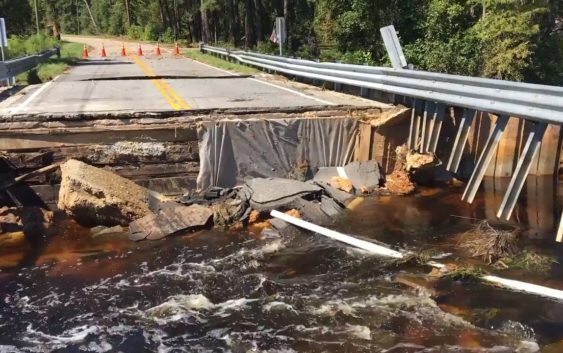- Hundreds of brush fires burn across North Carolina Saturday; several fires still burning Sunday
- Texas’ biggest wildfire started a year ago. How does the Panhandle look now?
- To her, Hurricane Helene debris isn’t trash. It is full of memories — and she’s returning them
- Bills introduced a year after state’s largest blaze seek to limit wildfires
- A year after Texas’ largest wildfire, Panhandle residents tugged between hope and anxiety
Hurricanes show the benefits, limits of dams

Over the past week, rivers in North Carolina have broken previous flood records, many of which were set by Hurricane Matthew just two years earlier.
Hurricane Florence dropped 2 to 3 feet of rain, causing major flooding along the Cape Fear, Lumberton, and Neuse rivers. The Cape Fear River alone carried more than 62,000 cubic feet of water per second — enough to overfill an Olympic swimming pool every two seconds — which destroyed property and highlighted the limits of our country’s infrastructure.
Upstream of the flooding on the Cape Fear and Neuse rivers are large dams and reservoirs built and operated by the U.S. Army Corps of Engineers, an agency that came under increasing scrutiny after Hurricane Katrina in 2005 and again in 2011 regarding how they operated their dams on the Mississippi and Missouri rivers during flooding.
On the one hand, the Army Corps needs to keep reservoirs full to provide drinking water, hydropower, navigation, and recreation; but on the other hand, they need to keep reservoirs empty to assist with flood control.
We spent the past few years building a database to understand how Army Corps reservoirs balanced this two-fold task across the nation. We learned that these competing purposes become particularly problematic in the Southeast in the late summer as the need for water stored in the reservoir is highest and the risk for hurricanes is greatest.
To balance these needs, the Army Corps develops “water control plans” to operate reservoirs. These plans lay out how empty or full a particular reservoir should be on any given day of the year. Along with this, the Army Corps records the water level at each reservoir to show how the dams are operated in real-time.
These data let us see how reservoirs operated leading up to Hurricane Florence. It showed that the Army Corps operated its North Carolina reservoirs according to their water control plan up until flooding began. As Hurricane Florence began dumping rain, these reservoirs captured the flow of rivers upstream of the dam, and stopped releasing water downstream to reduce flooding, essentially cutting off the upstream contribution to ongoing downstream flooding.
Once rivers drop below flood stage, the Army Corps gradually begins releasing flows to return the reservoir to normal operations, clearing space to store future storms. As of Sept. 19, 2018, both Jordan and Falls Lake have more than doubled the amount of water stored prior to the hurricane with Jordan Lake on the Cape Fear River rising 15.5 feet and Falls Lake on the Neuse River rising 7.7 feet. Water levels continue to rise in both reservoirs, storing water that would otherwise add to the deluge downstream.
The whole system is simple in concept, but incredibly critical infrastructure that represents a staggering achievement of engineering and planning. All this said, it’s important to recognize a few key aspects of Army Corps dams.
First, in times of drought, the Army Corps can be criticized for not diverting from their water control plans and using reservoirs to store more water for water supply. Events like Florence are a good reminder that these reservoirs have multiple purposes, and shifting off their plans — storing more water — could create incredible flood risk.
Although these reservoirs are performing as intended, there are limits to infrastructure. There have been and will be floods that these dams will not be able to store. This is not unique to the Southeast. In 1983, the Colorado River exceeded expectations and began flowing over the top of the gargantuan Glen Canyon Dam. In 2011, the Army Corps’ system of reservoirs throughout the Missouri, Tennessee, and Ohio basins were just barely able to contain incoming floodwaters.
This was a big flood, but it was not an extraordinary one. All infrastructure has limits and at some point there will be a flood that is simply beyond the capacity of any dam, including the storage of Falls and Jordan lakes. The limits of our reservoirs and water infrastructure will be pushed sooner than later.
Whether or not we want to admit it, climate change matters. A warming climate allows more precipitation to be held in the atmosphere, increasing the potential for high-intensity precipitation, and appears to create conditions that make “stalling” hurricanes like Florence, and what Texas saw with Harvey, more likely. The Army Corps’ infrastructure operated and performed incredibly well during Hurricane Florence. However, the efficacy of this, and all water infrastructure, will be challenged in the future. We can rely on it only so much, and likely need to begin expecting floods for which this infrastructure is ineffective.
Martin Doyle is the director of the Water Policy Program at Duke’s Nicholas Institute for Environmental Policy Solutions and professor of river science at Duke’s Nicholas School of the Environment. Lauren Patterson is a policy associate at the Nicholas Institute.